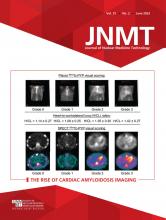Abstract
One of the most common malformations of the gastrointestinal tract is Meckel diverticulum (MD). MD complications can range from minor to major, such as intestinal obstruction, intussusception, hemorrhage, ulceration, vesicodiverticular fistulae, and tumors. Bleeding from ectopic gastric mucosa is more common in children than in adults. In the current case, MD in a 25-y-old man was diagnosed by 99mTc-pertechnetate scanning. 99mTc-pertechnetate scanning helps to diagnose MD noninvasively and has a potential role in the evaluation of MD even in adults.
One of the most common malformations of the gastrointestinal tract is Meckel diverticulum (MD), which is common in young children and rare in adults. MD complications can range from minor to major, such as intestinal obstruction, intussusception, hemorrhage, ulceration, vesicodiverticular fistulae, and tumors. Bleeding from ectopic gastric mucosa is more common in children than in adults (1). In the current case, MD in a 25-y-old man was diagnosed by 99mTc-pertechnetate scanning.
CASE REPORT
A 25-y-old man presented at King Saud Medical City. The patient complained of blood in his stool. There was no abdominal pain or discomfort. Physical examination did not show any specific indication for the bleeding. There was no history of trauma. In addition, the patient had a high white blood cell count of 13.16/μL. The reference range for white blood cell counts at King Saud Medical City is 4–10/μL. Also, the patient’s hemoglobin level dropped to 6 (the reference range is 13–17 g/dL). Because of the patient’s symptoms, the drop in hemoglobin level, the melena, and small-bowel bleeding found on gastrointestinal endoscopy, CT angiography was ordered.
The CT scan revealed no sign of active bleeding within the bowel loops. There was a focal blind-ended tubular structure forming the distal ileal loop, which measured 2.3 × 1.3 cm and showed wall thickening and mural hyperenhancement (Fig. 1). There were no signs of an abdominopelvic collection or hematoma. The final impression from the CT angiogram was that there were signs of MD that needed to be confirmed by a 99mTc-pertechnetate scan.
Abdominopelvic CT scan of late arterial phase in axial (A), coronal (B), and sagittal (C) views. Focal blind-ended tubular structure forms distal ileal loop (arrows), measuring 2.3 × 1.3 cm.
The patient was instructed to take nothing by mouth for at least 4 h before the scan. Also, barium or contrast studies can affect nuclear medicine scans. The patient was injected with 370 MBq (10 mCi) of 99mTc-pertechnetate while lying supine under the γ-camera. The included area was from the xiphoid to the pubis. Flow dynamic images were obtained at a rate of 15 s per frame for 30 min. Also, a static image was acquired anteriorly over the same area for 5 min. Afterward, SPECT/CT was performed over the same region, using a 360° rotation and 128 × 128 matrix, at a rate of 30 s per frame.
The study demonstrated a focus of high-intensity uptake in the right lower quadrant. It was similar to the kinetics of the gastric mucosa (Fig. 2). The focus increased during the scan, suggesting active bleeding by an MD measuring 3.5 × 2.5 cm. On the posterior image, another focus was seen below the liver and was thought to be clearing of 99mTc uptake through the kidney. SPECT/CT confirmed that suspicion (Fig. 3). The patient was taken to the operating room for a laparotomy to remove the diverticulum, and the surgery was successful (Fig. 4). A surgical biopsy sample was sent to the histopathology unit, which confirmed the initial diagnosis.
99mTc-pertechnetate scan in anterior views for dynamic acquisition. (A) Focal uptake (arrow) is not fully visualized, even though slight uptake is seen. (B) Uptake (arrow) increased over time and was completely visualized by 50 min.
99mTc-pertechnetate scan in axial (A), coronal (B), and sagittal (C) views, with SPECT/CT obtained for conformation and anatomic purposes. Abnormal focus (arrows) increased during scan, suggesting active bleeding by MD.
(A and B) Intraoperative MD photographs before surgery (A) and showing resected diverticulum (B). (C) Photomicrograph showing small intestine mucosa (horizontal arrow) adjacent to gastric heterotopic mucosa (vertical arrow).
DISCUSSION
MD is one of the most common congenital malformations of the vitellointestinal duct. Historically, the first time MD was mentioned was in 1598, but it was not until 100 years later that MD was understood and recognized (1). Bleeding from ectopic gastric mucosa, especially chronic bleeding, is not common in adults (1). The main reason for bleeding is secretion of acid from the ectopic mucosa, with consequent ulceration of the ileal mucosa (2).
A “rule of 2s” applies to MD: it is usually 2 ft from the ileocecal junction; it is about 2 in (5 cm) long; it is present in 2% of the population; it is common in children under 2 y old; and it affects males 2 times as often as females (3).
Many adults with MD present with abdominal pain or bleeding, symptoms that might be confused with other conditions. In addition, laboratory tests and physical examinations are not helpful in MD (4). In this case, the MD could be seen on the CT angiogram but could not be confirmed until the 99mTc-pertechnetate scan was performed.
99mTc-pertechnetate scanning is superior to other modalities for diagnosis of MD, with a sensitivity of 80%–90% and a specificity of 95%, particularly in pediatric patients. Sensitivity may be less in adults, but to what extent is unknown because there are few reported cases of adults with MD being diagnosed using 99mTc-pertechnetate (5). In our patient, 99mTc-pertechnetate scanning was able to confirm the CT indication of MD and the histopathology results.
CONCLUSION
99mTc-pertechnetate scanning helps to diagnose MD noninvasively and has a potential role in the evaluation of MD even in adults.
DISCLOSURE
No potential conflict of interest relevant to this article was reported.
Footnotes
Published online Feb. 7, 2023.
- Received for publication November 3, 2022.
- Revision received January 13, 2023.











